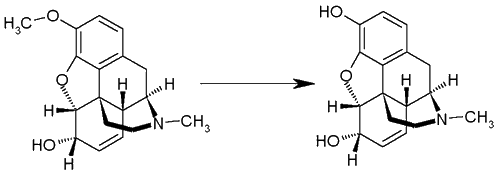DESOMORPHINE
What is it?

It’s the active principle of the drug called Krokodil.
Its IUPAC name is 4,5-α-epoxy-17-methylmorphinan-3-ol and its formula is C17H21NO2.
Desomorphine (dihydrodesoxymorphine, Permonid) is an opioid that is a derivative of morphine, where the 6-hydroxyl group has been removed and the 7,8 double bond has been reduced.
It has sedative and analgesic effects, and is around 8-10 times more potent than morphine
Scientists first developed this drug in 1932 while looking for a way to treat chronic pain without the nausea and respiratory problems linked to morphine.
Researchers found desomorphine quickly killed pain with long-lasting results, but also led to rapid addiction.

Biosynthesis
The Demethylation of Codeine to Morphine
p=. 
Synthesis of desomorphine

Effects (if we consider desomorphine as a pure drug)
The effects are the same of morphine but five time stronger both in duration and in addiction.
In general opioids have two actions that may help in pain reduction.
Within the brain they can distract it somewhat from thinking about pain.
The strongest drugs available can cause people to feel distanced, have mild hallucinations or produce a “high.” The other thing that an opioid does is bind to opioid receptors.
These receptors would normally send signals to the brain alerting it to pain, but with this binding, they are unable to communicate effectively.
Interestingly, an opioid may also inhibit coughing, and explains why these medications are sometimes used for very bad coughs; codeine cough syrup is one well-known formulation.
Krokodil

Desomorphine or krokodil is a home-cooked opiate-based drug that is reportedly up to ten-times stronger than heroin and many times cheaper and toxic.
Krokodil is increasingly being used by heroin addicts in parts of Europe as a replacement for heroin but the horrific effects the drug has on the body mean that users don’t have their addiction very long. Users will often die within 2 years of using this home-made drug that is a combination of pain medication and toxic chemicals.
How is it made?
Desomorphine can be manufactured with codeine tablets, a controlled substance in the United States prescribed for pain. In addition to codeine, krokodil contains gasoline, paint thinner, or lighter fluid. Other ingredients include red phosphorus scraped from the ends of matchsticks, hydrochloric acid, and iodine. The solution is considered 10 times more powerful and toxic than heroin.
Drug experts say epidemic use in Russia might stem from the lack of government-sponsored drug rehabilitation programs for heroin addicts, along with easy access to codeine tablets. After addiction to desomorphine, withdrawal from the drug can last a month, with severe pain, compared to about five days to withdraw from heroin. Most users become addicted the first time they inject the drug.
Desomorphine is typically home made and can be made from a combination of codeine-based tablets, paint thinner, lighter fluid, gasoline, hydrochloric acid, red phosphorous (scraped from matchboxes) and iodine.
The result of the cooking of pain tablets and chemicals is a toxic and highly addictive drug.Users often continuously cook up the drug in their kitchen to ensure they can maintain their high.
The caramel-colored liquid is injected into damaged and gangrenous areas giving users a high that will last 30 minutes at most.
Which is the action?
The toxic nature of these chemicals in krokodil cause users skin to change color, turn scaly and eventually become gangrenous. Users skin will be covered in ulcerations around the injection sites as blood vessels rupture and cause tissue to die.
Photographs suggest that users skin will be eaten away by the chemicals in the drug which rots flesh to the bone.
Users teeth with literally rot out of their heads, brain damage is common and tetanus and blood poisoning is nearly assured.
Reports suggest that the use of krokodil is increasing in poor regions such as isolated parts of Russia where heroin is difficult to find. Up to 5 per cent of Russian drug users reportedly are now using krokodil or other home-made drugs.
According to drug workers, krokodil has higher addiction rates and is harder to get off of than heroin.
Users will go through severe and painful withdrawals for up to a month after stopping use, but the long term effects of the drug will last longer.
Brain damage, hepatitis, rotted teeth, amputations are some of the side effects.
Heavy metals in red phosphorus destroy bone and harm the body’s central nervous system, which could lead to brain damage.
Iodine weakens muscle tone, causing atrophy.
Chemicals used to make the drug also disrupt the normal balance of minerals and build up in the liver and kidneys, which could cause organ failure.
Teeth typically rot away as skin turns green and scaly.
More than one-third of users become ill with hepatitis C, and most die within a year or two.

Sitography
http://www.narconontop.org/informazioni_droghe.htm
http://www.erowid.org/archive/rhodium/chemistry/codeine2morphine.html
http://www.sostanze.info